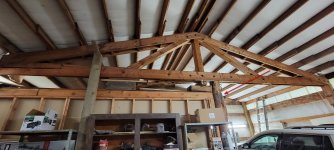RobertEH
Gold Member
I have a neighbor who had a bean on one of the truss’s in his shop break (allegedly due to snow load, but it happened prior to him purchasing the property).
I offered to help him replace it. The plan is:
1 Using the forks on the tractor, provide just enough upward pressure on the rafter to allow removal of the broken beam. We will brace the loader once we have the rafter lifted for safety.
2 remove the bolts in the fractured truss and replace with new wood
3 lower the forks so the roof settles in on the new wood.
Any faults with this plan?
In the photo, the red circle shows the broken beam, and the blue arrow shows the rafter we will put upward pressure on.

I offered to help him replace it. The plan is:
1 Using the forks on the tractor, provide just enough upward pressure on the rafter to allow removal of the broken beam. We will brace the loader once we have the rafter lifted for safety.
2 remove the bolts in the fractured truss and replace with new wood
3 lower the forks so the roof settles in on the new wood.
Any faults with this plan?
In the photo, the red circle shows the broken beam, and the blue arrow shows the rafter we will put upward pressure on.
